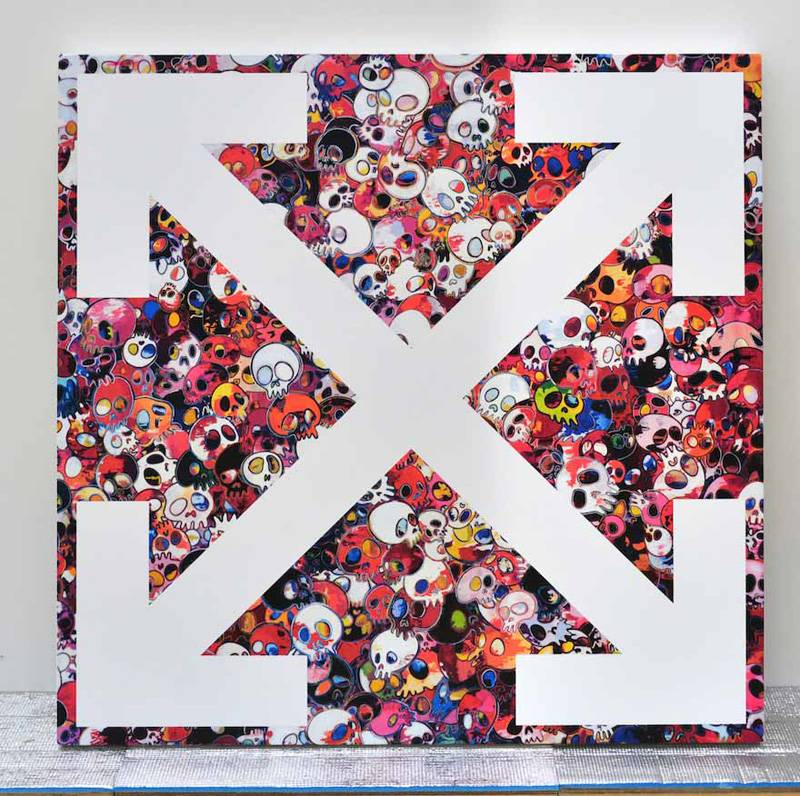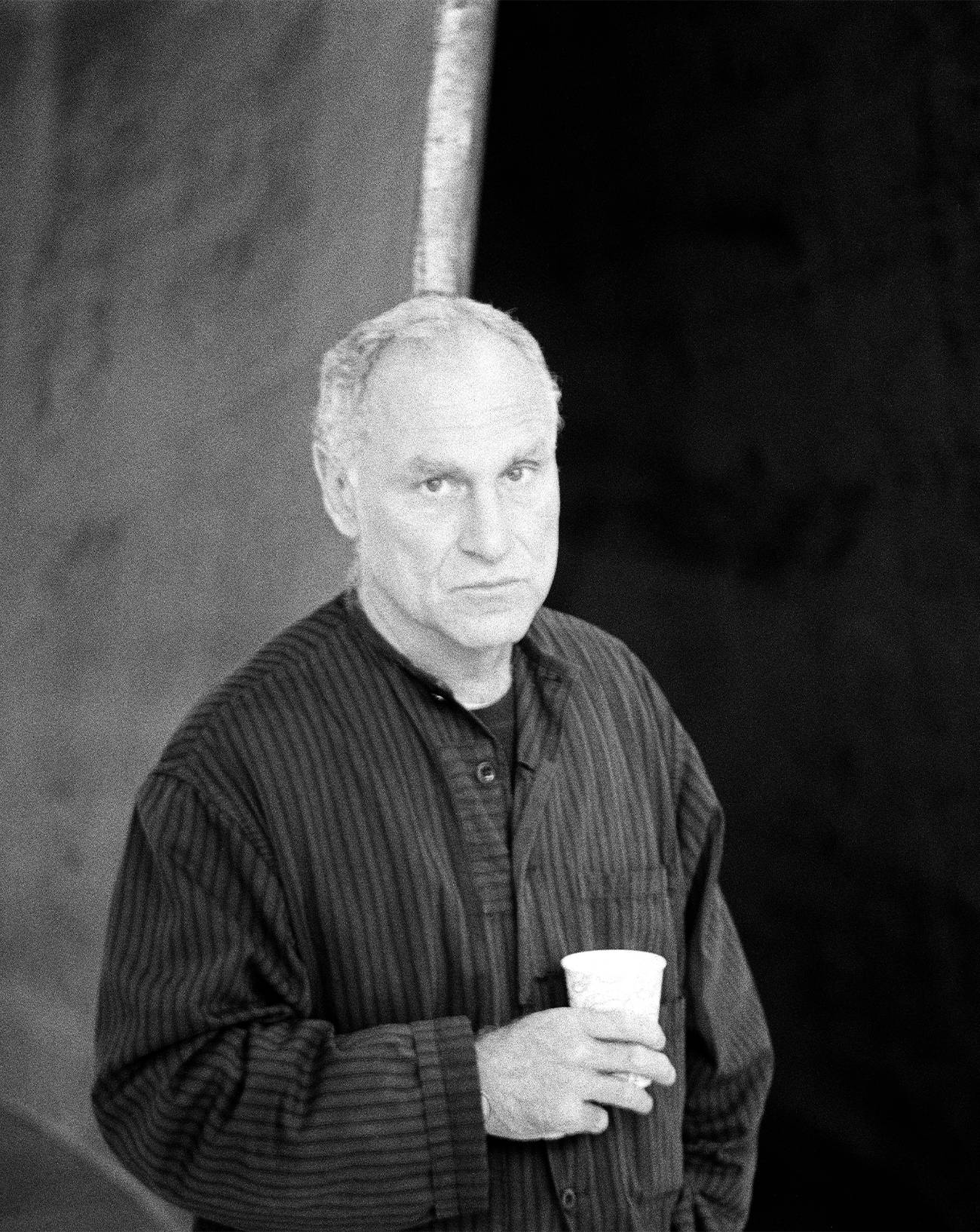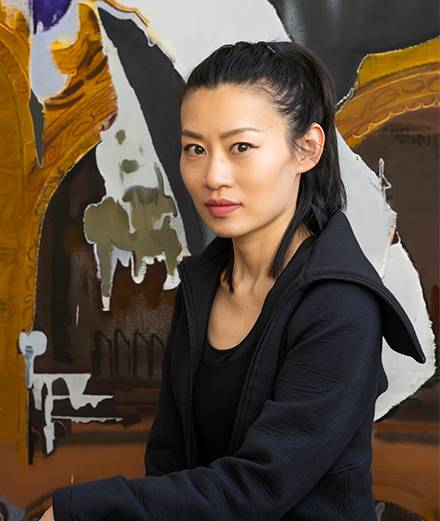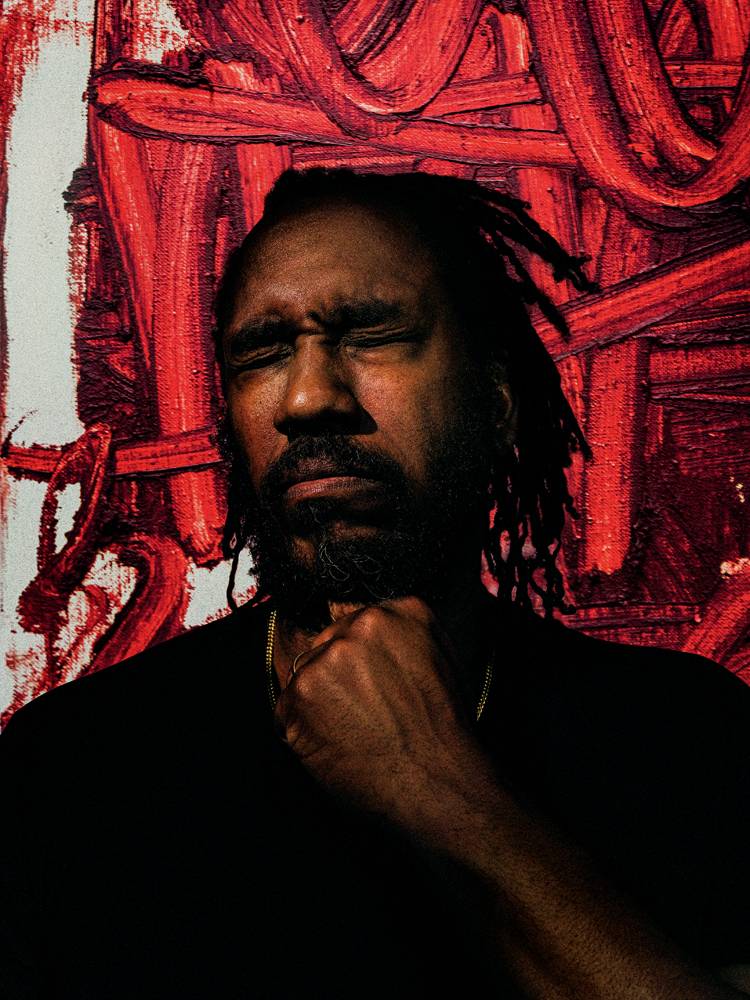NUMÉRO: How did this all start? Did you meet each other or were you aware of each other’s work from seeing it online?
TAKASHI MURAKAMI: Last year, when I had a show at the MCA in Chicago, I ran into Virgil again. He was the artistic director for Kanye West who I collaborated with years ago, and he had visited my studio. Then at ComplexCon in November, in Long Beach, California, we screened a T-shirt together. What is ComplexCon? It’s a festival of sneak- erheads. I didn’t know about sneak- erheads, but sneakerheads knew me, and for them, Virgil is basically the king.
I notice you’re wearing Off-White sneakers – good product place- ment going on there!
TM: Yes, thank you for that. At ComplexCon we participated in a panel discussion. Virgil was coming from the background of architecture and fashion, but he really had an earnest vision about art. If we collabo- rated, I thought, the sneakerheads would be very interested in what he does, and those audiences might actually have a chance to look into art.
Virgil, how did you first get to know Takashi’s work? What grabbed you? Why were you interested in working together?
VIRGIL ABLOH: I identified with “superflat” as a description of culture and people at the time. That’s my entry point into his visual vocabulary and the work. So from that stand-point, but even more so the role of contemporary artists in society, I connect with how his work faces people. I thought that it was powerful if we did something together, within this space.
In terms of physically creating, what did you find as the connection points?
TM: We’ve been communicating throughout this project on WhatsApp, and I’ve been getting a barrage of information from Virgil. There’s this sense of speed, and I got so happy and excited about it, I wanted to keep going, to catch up with that speed.
VA: It sends a profound message collaborating in this sort of way, making artworks, not necessarily clothing. This feels very new because at the core, I’m an artist, but I’ve enlarged, perhaps, the works that people have seen, and through other mediums, whether that be a pair of shoes, or a clothing project, or my history in architecture and cre- ative direction. This is a defining moment – to distil those ideas into works of art.
In technical terms, were you sharing visual stimuli, shapes, colours, thoughts?
VA: Yes, we’re both very hands-on. We think of an idea, we visualize it, and then we present it to each other, and that’s the process by which these pieces were created. They started off as mock-ups. My training is in architecture, so it’s a similar process to what I normally do. Everything was thought of, digitally mocked up and then made in real life.
TM: The aspect that was most exciting to me was the fact that we’re exchanging ideas on WhatsApp, I see him posting something he especially liked, and I know, “Oh, that’s what he’s more interested in right now.” Depending on how many people like it immediately, I also know, “Oh, this is the kind of thing that people like to see.” One of the things that was unique and interesting about this collaboration was communicating through social media.


Portrait par Olivia Arthur.
“ I’m 56, so I’m kind of old. I learned all these things recently, but Virgil does it as if he’s breathing – so I’m learning from him!”
Takashi Murakami
How did you conceive the hang for the show here at Gagosian Davies Street?
VA: We very much thought about the space. A lot of these pieces were created knowing this particular gallery. We wanted to do a mixture between paintings and sculptures, and relate it to the street so that when you stand on the street, that sculpture relates to the painting behind it.
You’ve incorporated motifs that relate to Off-White into these works as well.
VA: Yes, it’s like I rebranded my brand with art.
Tell me about the sculpture of a house that’s in the show. Is it a reference to your background in architecture?
VA: Exactly. That pitched-roof archi- tecture is an “idea of home.” I often speak in quotes! Then, giving it a different sensibility by disrupting it, and also re-contextualising it with the text “Life Itself.” The greenhouse is meant to sustain life, and so it’s a figurative take on that.
It also reads very much as a branding exercise once again.
VA: Yes, that’s my voice. I regularly use Helvetica in Off-White to reclaim or reprogram a tangible object.
Takashi, in the time that you’ve been working, visual culture has changed very dramatically, par- ticularly with the arrival of social media and applications like Instagram.
TM: I had a period when I really thought that I needed to change the way I’m involved in social media. There were Japanese victims be headed by Isis, and the videos were going viral. I watched them a lot. When I realized I was doing that, I re- alized how the power of social media is dramatically changing, and how it’s affecting me. I was becoming aware of how the way we input and output information has really changed. I’m 56, so I’m kind of old. I learned all these things recently, but Virgil does it as if he’s breathing – so I’m learning from him!

“My context is not leaving fashion or doing anything else. It’s subscribing to four blank walls, and inserting ideas that represent my thinking.”
Virgil Abloh
What’s the extent of this collaboration? Is it just a body of art-works? Does it extend across apparel, objects, editions? Is there potential for there being a new series of works in the future?
VA: We started it without limits. The concept is free to evolve into whatever opportunities. The first thing we did together was to my mind was a performance-art piece. We were both screen-printing in a glass box. There was a two-way mirror, so there were tons of kids on the outside, but inside, it was this serene thing. They basically saw us in our studio. So, yes, I would say that it could, but nothing’s planned.
TM: Contemporary art really originated in America and Europe, and so taste was based on the contemporary Western audience. Then, three or four years ago, the Asian markets started growing, and the taste for subculture-based art has been growing. Now there exists this com- pletely different taste between the China-centred Asian market and the Western market. The needs are huge, and the money that’s moving based on that taste is huge. The situation has been changing a lot. Virgil has been enjoying amazing popularity in China, and I thought some of my popularity there overlaps a bit, at the core. I thought if we did a collab- oration together, there would be a huge reaction, but especially in the realm of art. I wanted to do this in a commercial gallery setting, and especially with Gagosian. How it’s be received here will be very interesting.
Historically, being an artist is seen as the ultimate expression of creative freedom. Is this still a compelling archetype?
VA: It’s been said in a number of dif- ferent contexts, but anyone who has a will to create is an artist. We’re the end of labels. In the realm of creativity, I literally don’t see the lines in the sand. I went to architecture school not to learn how to design buildings, but to design a spoon. I thought that if you could design a skyscraper, you could probably figure out anything else in the world. There’s definitely an artistic expression to making a clothing line. It’s something that continually burns creative energy. To answer your question: I just work in the same way, different mediums, and I work collaboratively. In 2019, I have an exhibition at the MCA in Chicago. My context is not leaving fashion or doing anything else. It’s subscribing to four blank walls, and inserting ideas that represent my thinking.
Is it work that exists nominally within the sphere of art? Or all kinds of creative output, be it a pair of sneakers, a design for a building, or the famous spoon?
VA: It’s one narrative. It’s basically a show that has no limit, because it’s my show, it’s me and the institution meeting halfway to say, “Hey, maybe the next generation of artists looks like this, doesn’t look like that.”
Apart from Takashi, who do you look to in the art world? Are there people who excite you?
VA: Yes, for sure. I’ve come from a specific set of mentors, everyone from Vanessa Beecroft to George Condo to Tom Sachs. I’ve spent a significant amount of the past ten years working with or alongside, and understanding, their practice. That’s helped me understand the direction I want to go with my life as an artist.
Do you also collect?
VA: I do, yes. But it’s the same thing. My art collection is one part tradi- tional, another part things that I value, from established artists to unknown artists. I look at everything I own as an art piece.











